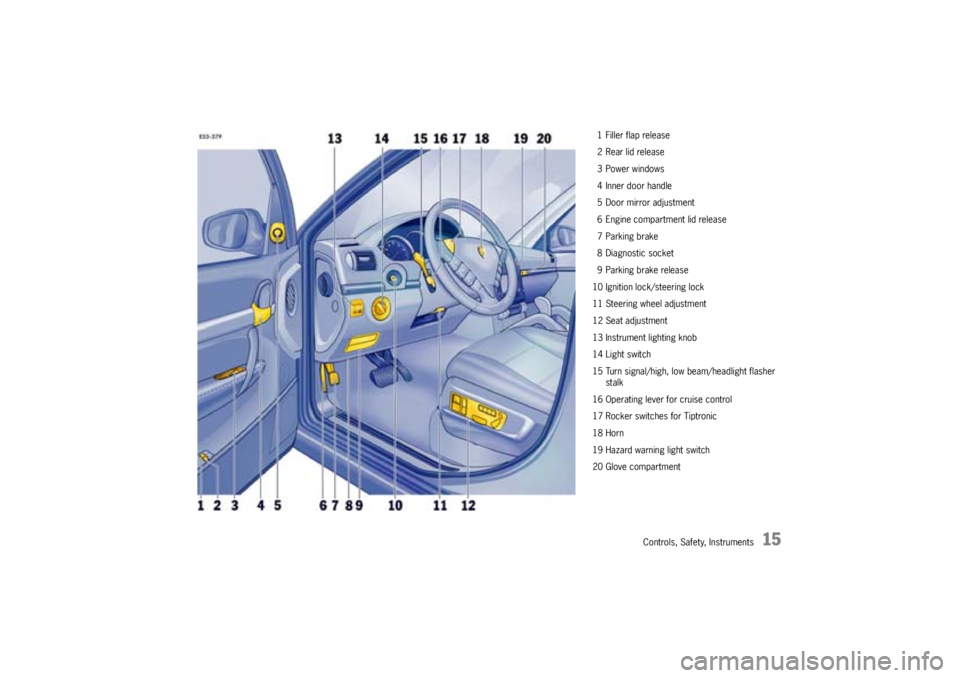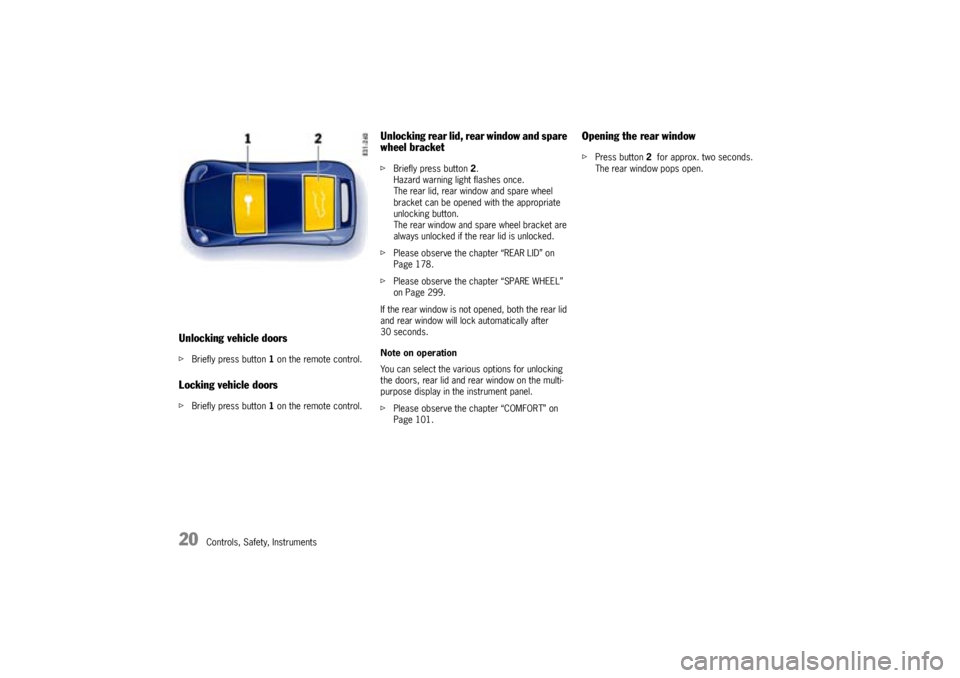door lock PORSCHE CAYNNE TURBO 2005 1.G Owners Manual
[x] Cancel search | Manufacturer: PORSCHE, Model Year: 2005, Model line: CAYENNE TURBO, Model: PORSCHE CAYENNE TURBO 2005 1.GPages: 369, PDF Size: 3.17 MB
Page 11 of 369

Controls, Safety, Instruments
11 Controls, Safety, Instruments
Porsche and the Environment .......................... 4
Never invite car theft! .................................... 16
Keys ............................................................ 17
Central Locking System ................................ 21
Porsche Entry & Drive ................................... 24
Doors .......................................................... 26
Alarm System, Ultrasound Passenger Compart-
ment Monitoring System, Inclination Sensor .... 27
Power Windows ............................................ 29
Front seats................................................... 32
Front seat with memory................................. 33
Easy Entry Function ...................................... 35
Headrests .................................................... 36
Rear Seats ................................................... 37
Heated Seats – Front and Rear ...................... 40
Safety Belts.................................................. 42
Child Restraint Anchorages ............................ 46
Child Restraint Systems ................................ 47
Airbag Systems ............................................ 49
Steering Wheel ............................................. 51
Multi-Functional Steering Wheel ...................... 53
Interior Mirror ............................................... 55
Door Mirrors................................................. 55
Automatic Anti-Dazzle Mirror .......................... 57
Ignition Lock/Steering Lock ........................... 58
Starting and Stopping the Engine ................... 60
Parking Brake ............................................... 62
Brakes ......................................................... 63
Instrument Panel USA Models ........................ 68
Instrument Panel Canada Models.................... 70
Oil Temperature Gauge ................................. 72
Speedometer ............................................... 72Cooling System ............................................ 73
Fuel ............................................................. 74
Odometer..................................................... 75
Emission Control........................................... 76
Multi-Purpose Display .................................... 78
Warning Lights and Warning Messages ......... 106
Light Switch ............................................... 114
Instrument Illumination ................................. 116
Automatic Headlight Beam Adjustment ......... 116
Turn signal/High Beam/
Headlight Flasher Stalk ................................ 117
Emergency warning lights............................ 118
Windshield Wiper/Washer Stalk .................... 119
Cruise Control ............................................ 122
Vents ......................................................... 125
Fresh-air intake ........................................... 125
Heated Rear Window ................................... 126
Automatically Controlled
Two-Zone Air Conditioning ........................... 127
Automatically Controlled
Four-Zone Air Conditioning ........................... 131
Parking Heater............................................ 137
Sun Visors .................................................. 142
Sun Blinds, Rear Side Windows .................... 143
Interior Lighting .......................................... 144
Door-Surrounding Lighting ........................... 146
Coming Home Function (Off Delay) ............... 146
Sliding/Lifting Roof ..................................... 147
Parking Aids ............................................... 157
Garage Door Opener ................................... 162
Ashtray ...................................................... 165
Cigarette Lighter......................................... 166Car Audio Operation/Tips ............................ 167
Porsche Communication
Management (PCM) ..................................... 170
Fire Extinguisher ......................................... 171
Storage...................................................... 172
Cupholder .................................................. 176
Rear Lid ..................................................... 178
Rear Window .............................................. 180
Engine Compartment Lid ............................. 180
Loadspace ................................................. 182
Luggage Compartment Cover ...................... 183
Luggage Safety Net ....................................185
Ski Bag ...................................................... 187
Roof Transport System................................ 189
Trailer Coupling .......................................... 190
Loading Information ....................................191
Page 13 of 369

Controls, Safety, Instruments
13
In the driver's seat...fCheck operation of the horn.
fPosition seat for easy reach of foot pedals and
controls.To reduce the possibility of injury from
the airbag deployment, you should always sit
back as far from the steering wheel as is prac-
tical, while still maintaining full vehicle control.
fAdjust the inside and outside rear view mirrors.
fBuckle your safety belts.
fCheck operation of the foot and parking brake.
fCheck all warning and indicator lights with igni-
tion on and engine not running.
fStart engine and check all warning displays for
warning symbols.
fNever leave an idling car unattended.
fLock doors from inside, especially with chil-
dren in the car to prevent inadvertent opening
of doors from inside or outside. Drive with
doors locked.
On the road...fNever drive after you have consumed alcohol
or drugs.
fAlways have your safety belt fastened.
fAlways drive defensively.
Expect the unexpected.
fUse signals to indicate turns and lane changes.
fTurn on headlights at dusk or when the driving
conditions warrant it.
fAlways keep a safe distance from the vehicle in
front of you, depending on traffic, road and
weather conditions.
fReduce speed at night and during inclement
weather.
Driving in wet weather requires caution and re-
duced speeds, particularly on roads with
standing water, as the handling characteristics
of the vehicle may be impaired due to hydro-
planing of the tires.
fAlways observe speed limits and obey road
signs and traffic laws.
fWhen tired, get well off the road, stop and take
a rest. Turn the engine off. Do not sit in the ve-
hicle with engine idling.
Please observe the chapter “ENGINE EX-
HAUST” on Page 6.fWhen parked, always set the parking brake.
Move the Tiptronic selector lever to “P“.
On hills also turn the front wheels toward the
curb.
fWhen emergency repairs become necessary,
move the vehicle well off the road. Turn on the
emergency flasher and use other warning de-
vices to alert other motorists. Do not park or
operate the vehicle in areas where the hot ex-
haust system may come in contact with dry
grass, brush, fuel spill or other flammable ma-
terial.
fMake it a habit to have the engine oil checked
with every fuel filling.
Page 15 of 369

Controls, Safety, Instruments
15
1 Filler flap release
2 Rear lid release
3 Power windows
4 Inner door handle
5 Door mirror adjustment
6 Engine compartment lid release
7 Parking brake
8 Diagnostic socket
9 Parking brake release
10 Ignition lock/steering lock
11 Steering wheel adjustment
12 Seat adjustment
13 Instrument lighting knob
14 Light switch
15 Turn signal/high, low beam/headlight flasher
stalk
16 Operating lever for cruise control
17 Rocker switches for Tiptronic
18 Horn
19 Hazard warning light switch
20 Glove compartment
Page 16 of 369

16
Controls, Safety, Instruments
Never invite car theft!An unlocked car with the key in the ignition lock in-
vites car theft.
A steering wheel lock and a gong alarm are stan-
dard equipment in your Porsche. The gong alarm
will sound if you open the driver's door while the
key is still in the ignition lock. It is your reminder to
pull the key out of the ignition lock and to lock the
doors.
Warning!
Any uncontrolled movement of the vehicle
may result in serious personal injury and
property damage.
Never leave your vehicle unattended with the
key in the ignition lock, especially if children
and/or pets are left unattended in the vehi-
cle. They can operate power windows and
other controls. If the engine is left running,
they may accidentally engage the shift lever.
fAlways remove the ignition key.
fAlways set the parking brake.
fLock the doors with the key or with the remote control.
Warning!
Risk of a serious accident.
The steering column will lock when you re-
move the key while you are driving or as the
car is rolling to a stop. You will not be able to
steer the car.
fNever remove the key from the steering lock while you are driving.To protect your vehicle and your possessions
from theft, you should always proceed as fol-
lows when leaving your vehicle:
fClose windows.
fClose sliding/lifting roof or Panorama Roof
System.
fRemove ignition key (switch ignition off in vehi-
cles that have Porsche Entry & Drive).
fEngage steering lock.
fLock storage tray between the front seats and
glove compartment.
fRemove valuables (e.g. car documents, radio
control module, telephone, house keys) from
the car.
fLock doors.
fLock the glove compartment.
fClose oddment trays.
fCover luggage compartment with the luggage
compartment cover.
fClose rear lid and rear window.
Page 19 of 369

Controls, Safety, Instruments
19
Emergency operation – locking the doorsIf the central locking system fails, the doors can
only be locked if the emergency operation is
performed.
1. Open the passenger‘s door.
2. Remove cover A.3. Using the key bit, press red slide control B in
the direction indicated by the arrow.
4. Fit cover A again.
5. Repeat procedure on the passenger‘s and the
rear doors.
6. Close all doors.
7. Lock the driver's door with the key at the door
lock.
ImmobilizerThere is a transponder (an electronic component),
containing a stored code, in each key.
Before the ignition is switched on, the ignition lock
checks the code.
The immobilizer can be deactivated and the en-
gine started only using an authorized ignition key.
Switching off the immobilizer
fInsert the ignition key into the ignition lock.
Switching on the immobilizer
fWithdraw the ignition key.
Page 20 of 369

20
Controls, Safety, Instruments
Unlocking vehicle doorsfBriefly press button 1 on the remote control.Locking vehicle doorsfBriefly press button 1 on the remote control.
Unlocking rear lid, rear window and spare
wheel bracketfBriefly press button 2.
Hazard warning light flashes once.
The rear lid, rear window and spare wheel
bracket can be opened with the appropriate
unlocking button.
The rear window and spare wheel bracket are
always unlocked if the rear lid is unlocked.
fPlease observe the chapter “REAR LID” on
Page 178.
fPlease observe the chapter “SPARE WHEEL”
on Page 299.
If the rear window is not opened, both the rear lid
and rear window will lock automatically after
30 seconds.
Note on operation
You can select the various options for unlocking
the doors, rear lid and rear window on the multi-
purpose display in the instrument panel.
fPlease observe the chapter “COMFORT” on
Page 101.
Opening the rear windowfPress button 2 for approx. two seconds.
The rear window pops open.
Page 21 of 369

Controls, Safety, Instruments
21
Central Locking SystemThis device complies with:
Part 15 of the FCC Rules
RSS-210 of Industry Canada.
Operation of this device is subject to the following
two conditions:
– It may not cause harmful interference, and
– it must accept any interference received in-
cluding interference that may cause undesired
operation.
Note
The manufacturer is not responsible for any radio
or TV interference caused by unauthorized modifi-
cations to this equipment.
Such modification could void the user's authority
to operate the equipment.
fPlease observe the chapter “POWER WIN-
DOWS” on Page 29.
fPlease observe the chapter “SLIDING/LIFTING
ROOF” on Page 147.The vehicle doors can be centrally unlocked or
locked with the remote control.
All doors are locked or unlocked if central locking
button A is activated in the relevant armrest.
Please observe the chapter “CENTRAL LOCKING
BUTTON” on Page 22.
The vehicle cannot be locked if the driver’s door is
not completely closed.
If you unlock the vehicle with the key at the door
lock, only the driver’s door is opened. In order to
prevent the alarm system from being triggered,
you must switch the ignition on within 15 seconds
of opening the door.
Switching off the alarm system if it is
triggered
fUnlock vehicle doors or
fSwitch ignition on.
Automatic relockingIf the vehicle is unlocked and none of the vehicle
doors is opened within approximately
30 seconds, automatic relocking takes place.
Note on operation
If the passenger compartment monitoring system
and the inclination sensor have been deactivated
(theft protection is limited), the doors can be
opened after automatic relocking by pulling the in-
ner door handle twice.
When locked again, the passenger compartment
monitoring system and inclination sensor are acti-
vated once more.
fPlease observe the chapter “ALARM SYSTEM,
ULTRASOUND PASSENGER COMPARTMENT
MONITORING SYSTEM, INCLINATION SEN-
SOR” on Page 27.
fPlease observe the chapter “ALARM” on
Page 101.Indication by the emergency flashersIf the vehicle doors are unlocked or locked, a re-
sponse is provided by the emergency flashers:
– Unlocking – single flash
– Locking – double flash
fPlease observe the chapter “SIGNAL” on
Page 103.
f f f USA: KR5KESSY
Canada: CAN 267 104 139
Page 22 of 369

22
Controls, Safety, Instruments
Locking conditionsfLock vehicle once.
The doors cannot be opened from the outside.
The alarm system, passenger compartment
monitoring system and inclination sensor are
switched on.
If a person or animal remains in the vehicle:
fQuickly lock vehicle twice.
The doors cannot be opened from the outside.
The passenger compartment monitoring
system and inclination sensor are switched off.
The doors are locked but can be opened from
the inside.
Unlocking the door with the inner door
handle
fPull inner door handle once.
Door lock is unlocked.
fPull inner door handle again.
Door can be opened.
fInform any persons remaining in the vehicle
that the alarm system will be triggered if the
door is opened.
Central locking buttonCentral locking buttons in the armrests let you
lock and unlock the vehicle electrically.
fPress the button A symbol.
All vehicle doors will be locked.
The doors can be opened by pulling the inner
door handle twice.
fPress the button A symbol.
If activated on the rear doors, only the relevant
door will be unlocked.
Note on operation
If the vehicle was locked with the key or by remote
control, it cannot be unlocked with the central
locking button.
The central locking buttons and the power
windows for the rear doors can be disabled using
safety button B in the armrest of the driver’s door.
Switching off
fPress safety button B.
The central locking buttons and power
windows on the rear doors are disabled.
Switching on
fPress safety button B again.
The central locking buttons and power
windows are operational. Locking
Unlocking
Safety button
Page 23 of 369

Controls, Safety, Instruments
23
Emergency operationfLock the vehicle with the key at the door lock.
If there is a defect in the central locking system,
operating the lock barrel in the driver's door will
lock all functioning elements of the central locking
system.
fThe fault should be remedied immediately at
an authorized Porsche dealer.
Note on operation
The alarm system, passenger compartment
monitoring system and inclination sensor are
switched on.
In order to prevent the alarm system from being
triggered, you must switch the ignition on within
15 seconds of opening the door.
Switching off the alarm system if it is
triggered
fUnlock vehicle doors or
fSwitch ignition on.
Automatic door locking
Warning!
In an emergency situation where you need to
exit the car through an automatically locked
door, remember the following procedure to
open the door.
fUnlock the doors by pressing the central lock-
ing button or
fpull the inside door handle twice to open the door.
You can select various options for automatically
locking the doors on the multi-purpose display in
the instrument panel.
fPlease observe the chapter “DOOR OPENING”
on Page 102.
Option 1 (AUTO-LOCK)
Doors lock automatically when a speed of approx.
3 mph (6 km/h) is exceeded.
Option 2
The doors do not lock automatically.
Note on operation
Automatically locked doors can be unlocked with
the central locking button and opened by pulling
on the inside door handle twice.
Page 24 of 369

24
Controls, Safety, Instruments
Porsche Entry & DrivePorsche Entry & Drive facilitates keyless unlock-
ing and locking of vehicle doors, rear lid and rear
window. To use this facility, you need to have only
the car key with remote control with you.
fDo not expose the car key to a high level of
electromagnetic radiation, as this could ad-
versely affect Porsche Entry & Drive.
Caution!
Risk of being locked out of vehicles with
Porsche Entry & Drive.
fIf the vehicle is locked and access is gained
through the rear lid or rear window, do not
leave the key in the vehicle.
The vehicle is automatically locked within ap-
prox. 30 seconds after the rear lid or rear win-
dow is closed.
The vehicle can then be unlocked only with the second key.
Unlocking vehicle doorsfGrip door handle fully.
The vehicle doors will be unlocked.Unlocking rear lid, rear window and spare
wheel bracketfIf you are at the rear section of the vehicle with
the car key, the rear lid, rear window and spare
wheel bracket are unlocked and can be
opened.
Locking rear lid, rear window and spare
wheel bracketfClose rear lid, rear window and spare wheel
bracket.
If the car key with remote control is out of
range, rear lid, rear window and spare wheel
bracket are locked.Locking vehicle doorsfPress button A in the door handle.
The vehicle doors are locked.
If the car key with remote control is out of
range, the vehicle doors are locked.
fPlease observe the chapter “LOCKING CONDI-
TIONS” on Page 22.
fPlease observe the chapter “ALARM SYSTEM,
ULTRASOUND PASSENGER COMPARTMENT
MONITORING SYSTEM, INCLINATION SEN-
SOR” on Page 27.
fPlease observe the chapter “SIGNAL” on
Page 103.